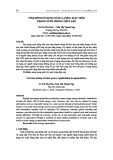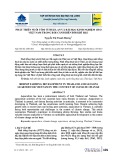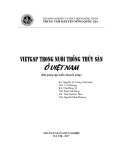
* Corresponding author.
E-mail address: ptthoai@uneti.edu.vn (T. T. H. Pham)
© 2020 Growing Science Ltd. All rights reserved.
doi: 10.5267/j.ccl.2019.8.002
Current Chemistry Letters 9 (2020) 79–88
Contents lists available at GrowingScience
Current Chemistry Letters
homepage: www.GrowingScience.com
A study to use activated sludge anaerobic combining aerobic for treatment of high
salt seafood processing wastewater
Thi Thu Hoai Pham
a*
and Thi Mai Huong Nguyen
b
aDepartment of Science research, University of Economic and Technical Industries, Vietnam
bDepartment of Food Technology, University of Economic and Technical Industries, Vietnam
C H R O N I C L E A B S T R A C T
Article history:
Received August 2, 2019
Received in revised form
August 18, 2019
Accepted August 19, 2019
Available online
August 19
,
201
9
Seafood processing operations generate a high strength wastewater, which contain organic
pollutants in soluble, colloidal, particulate form and salt content, up to 30g NaCl/L. This
research aimed to study the effect of salt (NaCl) concentration on the treatment efficiency of
seafood processing wastewater by the use of a laboratory-scale bioreactor, which is operated
in anaerobic combining aerobic system with concentration salt different from 0- 5%. The
results showed that the wastewater from seafood processing with the chemical input
parameters of pH = 7 - 8.5, COD = 2000 mg / L, total nitrate nitrogen = 150 mg / L, NH4+ =
90 mg / L, total phosphorus = 50 mg / L, salt content 3% was treated with anaerobic activated
sludge content of 8000mg/l, 16HRT and combining an aerobic activated sludge content of
6000mg/l, 6HRT, DO=2-4mgO2/l with the acclimatization of 7% bacteria Bacillus velezensis
at high salinity The parameters output wastewater was treated according to standards QCVN
11-MT:2015/BTNMT (column B).
© 20
20
Growing Science Ltd. All rights reserved.
Keywords:
Seafood processing wastewater
Salt concentration
Activated sludge
Anaerobic
Aerobic
1. Introduction
Seafood processing operations generate a high strength wastewater, which contain organic
pollutants in soluble, colloidal, particulate form and salt content, up to 30 g NaCl/l. Saline
wastewater are usually treated through physico-chemical means, as conventional biological
treatment which is known to be strongly inhibited by salt (mainly NaCl). However,
physicochemical techniques are energy-consuming and their startup and running costs are high.
Nowadays, alternative systems for the removal of organic matter are studied, most of them are
involved with anaerobic or aerobic biological treatment
1
. However, biological activities in the
activated sludge system are sensitive to environmental factors such as temperature, pH,
dissolved oxygen and feed conductivity. The effect of salt on nitrification/denitrification
process is a major concern in recent years. Previous studies indicated that high salinity adversely
effects the reduction of chemical oxygen demand (COD) in normal wastewater plants of
activated sludge
2,3
. However, the adaptation of biomass to saline wastewater improved COD
reduction
4,5
.

80
Past studies with highly saline wastewater from seafood industry and RO or other membrane
processes treating wastewater effluent are inadequate to draw any conclusive inference on the
treat-ability of saline wastewater. In such water, high levels of nutrients (nitrogen ranging of 50-
60 mg/L and phosphorus ranging10-12 mg/L) are common features. A recent sequential batch
reactor (SBR) study concentrated on nutrient reduction from saline wastewater (artificial seafood
processing wastewater). The wastewater was prepared to have the approximate concentrations of
total COD 1000 mg/L, soluble COD 500 mg/L, TKN 120 mg/L, PO-P 20 mg/l
6
.
In this study,
the wastewater from seafood processing with the chemical input parameters of pH
= 7 - 8.5, COD = 2000 mg / L, total nitrate nitrogen = 150 mg / L, NH4+ = 90 mg / L, total phosphorus
= 50 mg / L, salt content 3% was treated with anaerobic activated sludge by combining an aerobic
activated sludge. Biological treatment involves the use of microorganisms to remove dissolved
nutrients from a discharge7-9. Organic and nitrogenous compounds in the discharge can serve as
nutrients for rapid microbial growth under aerobic, anaerobic, or facultative conditions. Biological
treatment systems can convert approximately one-third of the colloidal and dissolved organic matter
into stable end products and convert the remaining two-thirds into microbial cells that can be removed
through gravity separation. The organic load present is incorporated in part as biomass by the microbial
populations, and almost all the rest is liberated gas. Carbon dioxide (CO2) is produced in aerobic
treatments, whereas anaerobic treatments produce both carbon dioxide and methane (CH4). In seafood-
processing wastewaters, the nonbiodegradable portion is very low. The author reported nutrient
reduction efficiency over 95% in sequential bio-reactors with the acclimatization of bacteria Bacillus
velezensis at high salinity as reported by others4,5,10. The result of parameters output wastewater was
treated according to standards QCVN 11-MT:2015/BTNMT (column B).
2.
Results and discussion
2.1. Adaptation of activated sludge
In an activated sludge treatment system, an acclimatized, mixed, biological growth of
microorganisms (sludge) interacts with organic materials in the wastewater in the presence of
excess dissolved oxygen and nutrients (nitrogen and phosphorus). The microorganisms convert
the soluble organic compounds to carbon dioxide and cellular materials. Research results of
culture activated sludge and change of biomass content over time are shown in
Fig. 1.
and
Fig. 2
Fig 1.
MLSS, MLVSS/MLSS in aerobic tank
Fig 2.
MLSS, MLVSS/MLSS in anerobic tank
Fig. 1
shows the biomass content (MLSS) increased from 1000 to 4215 mg / L after 30 days
of activated sludge culture. At the first stage when starting to operate from day 1 to day 10, the
amount of microorganisms in activated sludge is at the stage of adapting to the wastewater
environment and the sludge develops slowly. To the growth stage of microorganisms with
nutrient-rich seafood processing wastewater, activated sludge is well developed, MLSS increases
rapidly from 1350 to 4215 mg / L. MLVSS / MLSS ratio assesses biomass density in activated

T. T. H. Pham and T. M. H. Nguyen / Current Chemistry Letters 9 (2020)
81
sludge ranging from 0.72 to 0.88. For normal activated sludge this ratio is usually 0.8. Thus, the
activated sludge used in the study has good adaptation and growth to wastewater.
Fig. 2
shows the initial activated sludge amount was 3000 mg / L, after 30 days of culture, the
mud content increased to 12150 mg / L. MLVSS / MLSS ratio ranges from 0.67 to 0.77, SVI index
from 56 to 95ml / g. Thus, the anaerobic sludge grows well and is of good quality.
2.2. Effect of salt concentration to efficiency
Experimental study of the effect of salt content (salinity) on processing efficiency, to survey
how much salt content will affect the processing efficiency of the system. Characteristics of
seafood processing wastewater used in the experiment with input parameters:
pH = 7 - 8.5, COD
= 2000 mg/L, total nitrate nitrogen = 150 mg/L, NH4+ = 90 mg/L, total phosphorus = 50 mg/L.
After the wastewater is treated in anaerobic tank, it will enter the aerobic tank for treatment.
During treatment, the activated sludge content and retention time are kept constant. The activated
sludge content in anaerobic tank is about 8000 mg/L, the retention time is 16 hours. In aerobic
tanks, the activated sludge content is about 6000 mg/L and the retention time (HRT) is 8 hours,
DO= 2-4mgO
2
/l. Result of salt concentration to efficiency at different concentration (0-6% NaCl
w/v)
11,12
is shown in
Fig. 3
:
Fig 3.
Effect of salt concentration(%NaCl) to efficiency
In show
Fig. 3
, we see that salt content affects the efficiency of COD, NH
4+
and PO4
3-
treatment.
When the salt content is 0%, the COD removal efficiency of the system reaches 98.47%, COD =
30 mg/L. When the salt content increased by 1%, 2%, COD efficiency decreased slightly to 98.04
and 97.29%, the COD content was 39.5 respectively; 56 mg/L. Similarly, for NH4 + and PO43-
treatment performance, when the salt content is 0%, NH
4+
and PO4
3-
treatment efficiency is
95.41%; 88.54%, NH
4+
= 7.8 mg/L, PO4
3-
= 3.6 mg/L. When the salt content was increased by
1% and 2%, the NH
4+
treatment efficiency was decreased to 94.82 and 94.97%, respectively and
the PO4
3-
treatment efficiency was decreased to 85.58 and 78.1%, respectively. It can be seen that,
with salt content less than 2%, there is not much change in the processing efficiency of the
system. When the salt content is 3%, the efficiency of treatment decreases markedly and does
not meet the output standard according to QCVN11-MT: 2015 / BTNMT (column B) COD is 150
mg/L, NH
4+
= 54 mg/L, PO4
3-
= 34 mg/L.
Thus, the treatment efficiency of activated sludge anaerobic combining aerobic system was
significantly affected when the salt content of seafood processing wastewater is greater than 3%.
High salinity can cause high osmotic stress or the inhibition of the reaction pathways in the organic
degradation process. This results in a significant decrease in biological treatment efficiency. In
addition, high salt content induces cell lysis, which causes increased effluent solids. The

82
populations of protozoa and filamentous organisms required for proper flocculation were also
significantly reduced by the elevated salt content
13–17
. Therefore, high salinity in fish processing
wastewater will lead to difficulties in biological treatment processes
13
. High salinity is generally
known to cause plasmolysis and loss of cell activity
18,19
.
2.3. Effect of the retention time (HRT) to efficiency
From the research results we understand the effect of salt content on the processing efficiency of the
system when the salt content of 3% affects the processing efficiency of the system. Therefore, when
the effect of retention times in anaerobic tank were 16 hours, 24 hours and retention times in an aerobic
tank were 6 hours and 8 hours for processing efficiency 20,21, we conducted two contents salt as 0%
and 3%, respectively.
Fig 4.
Effect of the retention time (HRT) to efficiency COD, NH
4+
and PO4
3-
at salt concentration
0%
For 0% salt
concentration
, changing the retention time from 22 hours to 32 hours, in which
anaerobic retention time is 16 hours and 24 hours, aerobic retention time is 6 hours, 8 hours shows the
treatment performance
COD, NH
4+
and PO4
3-
management increases when increasing anaerobic
process retention time. However, keeping the anaerobic retention time to 24 hours, changing aerobic
retention time to be 6 hours and 8 hours, the experimental results have shown that the treatment
efficiency increased not much. In general, the processing efficiency of the whole process for 30 hour
and 32 hour retention times was nearly equal. Thus, the anaerobic retention time of 16 hours can be
selected without prolonging up to 24 hours, the aerobic retention time is 6 hours, the system can still
handle well the output standards.
Fig 5.
Effect of the retention time (HRT) to efficiency COD, NH
4+
and PO4
3-
at salt concentration
3%
For 3% salt concentration, the treatment efficiency is much lower than the 0% salt content. The
anaerobic process performance is reduced by more than half, from over 60% to 30%. Processing
efficiency of the whole process ranges from about 97% to about 80%. When the anaerobic
retention time is 24 hours, the aerobic storage time is 8 hours, the processing efficiency does not
increase much compared with the anaerobic retention time of 16 hours, when the aerobic storage

T. T. H. Pham and T. M. H. Nguyen / Current Chemistry Letters 9 (2020)
83
time is 6 hours. Thus, through the graphs showing the processing efficiency of COD, NH
4+
and
PO4
3
with surveyed retention times, retention time can be selected during anaerobic process to be
16 hours, retention time in the aerobic process to be 6 hours is suitable for seafood processing
wastewater treatment system.
2.4. Effect of the activated sludge content to efficiency
Several reports have indicated the adverse effects of high salinity or shocks of NaCl on organic
removal efficiency and sludge settle ability
22,23
. In the treatment system with biological treatment
process, activated sludge plays an important role in determining the treatment efficiency of
pollutants and shortening the processing time. The experiment was conducted when the active
sludge content in anaerobic tank was fixed to 8000 mg/L and changed the activated sludge content
in aerobic tank with values of 4000 mg/L, 6000 mg/L and 8000 mg/L. The retention time of
anaerobic period is 16 hours, the aerobic time is 6 hours in (
Fig. 6
).
Fig 6.
Effect of the activated sludge content to efficiency COD, NH
4+
and PO4
3-
In Fig. 6, with activated sludge content of 4000 mg/L, the processing efficiency of COD, NH
4+
and PO4
3-
the whole process is 91.25%; 75.83%; 45.63%, the output value is 168 mg/L, 36.5
mg/L, respectively and 27.3 mg/L has not met the output standard. With activated sludge content
of 6000 mg/L, the processing efficiency of COD, NH
4+
and PO4
3-
the whole process is 97.32%;
94.54%; 87.56%, output values are 54 mg/L, 7.1 mg/L and 4.2 mg/L. The treatment efficiency is
higher than the activated sludge content of 4000 mg/L. Output parameter values have reached the
output standard. When increasing activated sludge content to 8000 mg/L, COD and NH
4+
treatment efficiency increased to 97.42% and 95.03%. In general, the higher the mud content, the
better the performance. However, the activated sludge content of 6000 mg/L and 8000 mg/L has
no significant difference in treatment performance. Thus, the sludge content of 6000 mg/L in
aerobic tank is suitable for treatment because if the activated sludge is too high, then handling the
excess sludge is also a problem.
2.5 Study on supplementation of saline microorganisms to improve processing efficiency
Salt concentrations above 2% (20 g/L NaCl) in the wastewater will affect the growth of the bacteria.
Study from Joong et al.24 in the experiment for examination of the salt effect on cellular growth shows
that there was no effect on cellular growth at concentrations of 1% and 2% NaCl, but they observed
that there was an effect on cellular growth at the concentration of 3.5% NaCl. Burnett22 reported that
operation of activated sludge process at salt contents higher than 20 g/L was characterized by poor
flocculation, high effluent solids, and a severe decrease in substrate utilization rate. Hamoda and Al-
Attar25 reported on the effect of standard sodium chloride on aerobic activated sludge treatment














![Bài giảng Kinh tế thủy sản [mới nhất]](https://cdn.tailieu.vn/images/document/thumbnail/2025/20250808/kimphuong1001/135x160/91611754640469.jpg)

![Kỹ thuật nuôi thâm canh cá lóc trong ao đất: Tài liệu [chuẩn/mới nhất]](https://cdn.tailieu.vn/images/document/thumbnail/2025/20250724/kimphuong1001/135x160/3731753342195.jpg)




![Kỹ thuật nuôi cá nâu trong ao đất: Tài liệu [Mới nhất]](https://cdn.tailieu.vn/images/document/thumbnail/2025/20250723/vijiraiya/135x160/29781753257641.jpg)
![Kỹ thuật nuôi cá mú trong ao đất: Tài liệu [Mới nhất]](https://cdn.tailieu.vn/images/document/thumbnail/2025/20250723/vijiraiya/135x160/85681753257642.jpg)



